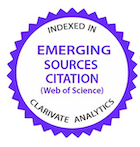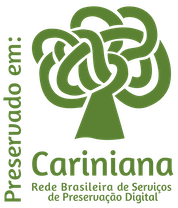Distribuição das artérias coronárias e análise histopatológica do coração de Bradypus variegatus
DOI:
https://doi.org/10.1590/1809-6891v25e-76956EResumo
A preguiça-comum (Bradypus variegatus) tem sido vítima das investidas antrópicas desordenadas, o que tem elevado o número de acidentes e doenças para a espécie. Propôs-se com esse estudo, realizar uma descrição das artérias coronárias, assim como apontar os achados histopatológicos do coração do bicho-preguiça, a fim de favorecer o diagnóstico por imagem, semiologia e clínica médica das espécies. Foram dissecados 18 exemplares de B. variegatus obtidos após morte natural. Quinze deles, sendo 5 machos e 9 fêmeas adultas e 1 jovem, foram fixados com formaldeído e conservados em solução salina. Em 2 machos e 1 fêmea, foi injetado, a partir da artéria carótida comum esquerda, látex corado em vermelho, para tornar as coronárias mais evidentes. Na fêmea também foi injetado através da veia jugular externa direita, látex corado em azul, para evitar equívoco na identificação arterial. Os animais tiveram o tórax aberto a fim de avaliar e retirar o coração para descrição detalhada das artérias coronárias. Para análise histopatológica, foram confeccionadas lâminas histológicas oriundas de corações coletados de 4 animais (3 adultos e 1 jovem). Com base nas análises arteriais, as preguiças possuem duas coronárias: uma a direita e uma a esquerda, que irrigam suas respectivas faces. O coração é composto por endocárdio, miocárdio e epicárdio, semelhante aos mamíferos em geral. Todavia, observou-se necroses endocárdicas, de fibras musculares cardíacas, além de degenerações mixomatosas de válvulas e trombos no lúmen vascular. Esses eventos necróticos, mais extensos, estão relacionados a infartos, enquanto os mais discretos podem ser associados a situações de estresse vivenciadas pelos espécimes.
Downloads
Referências
Miller LM, Gal A. Cardiovascular System and Lymphatic Vessels. Pathologic Basis of Veterinary Disease. 2017; 561–616.e1. Available from: https://doi.org/10.1016/B978-0-323-35775-3.00010-2
Mathew J, Sankar P, Varacallo M. Physiology, Blood Plasma. National Center for Biotechnology information. 2023. Available from: https://www.ncbi.nlm.nih.gov/books/NBK531504/
Gomes FGFLR, Farias ELP, Veronez DAL 2011. Estudo de pontes de miocárdio junto às artérias coronárias em cães. Revista de Educação Continuada em Medicina Veterinária e Zootecnia do CRMV-SP. 2011; 9(2): 36-36. Available from: https://www.revistamvez-crmvsp.com.br/index.php/recmvz/article/view/403
Fonfara S, Martínez Pereira Y, Rápido S, Copeland H, López-Alvarez J, Summerfield N, Cripps P, Dukes-McEwan J. Balloon Valvuloplasty for Treatment of Pulmonic Stenosis in English Bulldogs with an Aberrant Coronary Artery. Journal of Veterinary Internal Medicine. 2010; 24(2): 354-359. Available from: https://doi.org/10.1111/j.1939-1676.2009.0458.x
Albuquerque PV, Mesquita EP, Alcântara SF, Miranda MELC, Andrade GP, Amorim Júnior AA, Amorim MJAAL. External macroscopic anatomy of the Bradypus variegatus heart. Arquivo Brasileiro de Medicina Veterinária e Zootecnia. 2022; 74(5): 814-824. Available from: https://doi.org/10.1590/1678-4162-12562
Superina M, Aguiar JM. A reference list of common names for the Edentates. Edentata. 2006; 7(1): 33-44. Available from: https://doi.org/10.1896/1413-4411.7.1.33
Moraes-Barros N, Chiarello A, Plese T. Bradypus variegatus, 1825. The IUCN Red List of Threatened Species; 2014. Available from: https://doi.org/10.2305/IUCN.UK.2014-1.RLTS.T3038A47437046.en
Fuentes A, Hockings KJ. The ethnoprimatological approach inprimatology. American Journal of Primatology. 2010; 72(10): 841-7. Available from: https://doi.org/10.1002/ajp.20844
Xavier GAA, Amora TD, Valença YM & Cabral MCC. Apreensões de preguiças Bradypus variegatus SCHINZ, 1825 e casos de acidentes com choques elétricos envolvendo estes animais na Mesorregião Metropolitana do Recife, Pernambuco. In: Seabra GF, Silva JAN & Mendonça ITL (Org.), A conferência da Terra: aquecimento global, sociedade e biodiversidade. Vol.1. Editora Universitária da UFPB, João Pessoa; 2010. p. 301-308. Available from: https://docplayer.com.br/7278347-A-conferencia-da-terra-aquecimento-global-sociedade-e-biodiversidade.html
Pereira KF, Silva IO, Silva FFR, Silva VHD, Castro CSS, Boere V. Hematology and serum biochemistry of free-range brown-throated sloths in two urban areas in Brazil. Veterinary World. 2020; 13(9): 2033–2038. Available from: https://doi.org/10.14202/vetworld.2020.2033-2038
Alcântara SF, Amorim MJAL, Albuquerque PV, Mesquita EP, Miranda MELC, Andrade GP, Nascimento NEO, Nascimento JCS. Description of brachial plexus of sloth (Bradypus variegatus). Pesquisa Veterinária Brasileira. 2020; 40(10):824-829. Available from: https://doi.org/10.1590/1678-5150-PVB-6597
Pereira KF, Terra DRS, Ferreira LS, Sabec-Pereira DK, Lima FC, Santos OP. Anatomia do coração e vasos da base de Procyon cancrivorus. Arquivos do MUNDI. 2016; 20(3): 1-12. Available from: https://doi.org/10.4025/arqmudi.v20i3.34343
Ávila BHP, Machado MRF, Oliveira FS. Descrição anátomo-topográfica do coração da paca (Agouti paca). Acta Scientiae Veterinariae. 2010; 38(2): 191-195. Available from: http://hdl.handle.net/11449/2821
Guimarães JP. Análise morfológica e ultra-estrutural do coração do lobo-marinho-do-sul (Arctocephalus australis, Zimmermamm, 1793). Tese de Doutorado. (Programa de Pós-Graduação em Anatomia dos Animais Domésticos e Silvestres). Universidade de São Paulo, São Paulo; 2009. p. 99. Available from: https://doi.org/10.11606/T.10.2009.tde-03122010-105433
Pinheiro GS, Branco E, Pereira LC, Lima AR. Morfologia, topografia e irrigação do coração do Tamandua tetradactyla. Arquivo Brasileiro de Medicina Veterinária e Zootecnia. 2014; 66(4): 1105-1111. Available from: https://doi.org/10.1590/1678-6844
Soares GL, Oliveira D & Baraldi-Artoni SM. Aspectos da anatomia do coração do avestruz. Ars Veterinaria. 2010; 26(1): 38-42. Available from: https://doi.org/10.15361/2175-0106.2010v26n1p038-042
Correia-Oliveira M, Oliveira IMS, Roza MS, Abidu-Figueiredo M. Morfometria cardíaca e distribuição das artérias coronárias em coelhos Nova Zelândia (Oryctolagus cunniculus). Revista Brasileira de Medicina Veterinária. 2014: 36(2): 159-166. Available from: https://rbmv.org/BJVM/article/view/506
Rade W 2004. Origem, trajeto, ramificações e distribuição dos ramos ventriculares da artéria coronária direita no macaco-prego (Cebus apella). Dissertação de Mestrado. (Programa de Pós-graduação em Ciências Veterinárias). Universidade Federal de Uberlândia, Minas Gerais; 2004. p. 34. Available from: https://repositorio.ufu.br/handle/123456789/30170
Pinto Neto JL, Leão CES, Vieira THM, Lopes AKMS, Vieira SRC, Silva NC, Wafae GC, Ruiz CR, Wafae N. Indicadores anatômicos de dominância entre as artérias coronárias em caprinos. Brazilian Journal of Veterinary Research and Animal Science. 2009; 46: 48-63. Available from: https://pesquisa.bvsalud.org/portal/resource/pt/vti-5165
Smodlaka HH, Henry RW, Schumacher J, Reed RB. Macroscopic anatomy of the heart of the Ringed Seal (Phoca híspida). Anatomia, Histologia, Embryologia. 2007; 37(1): 30-35. Available from: https://doi.org/10.1111/j.1439-0264.2007.00791.x
Correia-Oliveira M, Hernandez JMF, Abidu-Figueiredo M 2013. Morfometria cardíaca e distribuição das artérias coronárias em bovinos mestiços. Biotemas. 2013; 26(2): 199-207. Available from: https://doi.org/10.5007/2175-7925.2013v26n2p199
Machado MRF, Borges EM, Oliveira FS, Filippini-Tomazini M, Melo APF, Duarte JMB. Intramyocardial course of the coronary arteries in the marsh deer (Blastocerus dichotomus). Brazilian Journal of Veterinary Research and Animal Science. 2002; 39(6): 285-287. Available from: https://doi.org/10.1590/S1413-95962002000600002
Kaimkhani ZA, Ali MM, Faruqi AM. Pattern of coronary arterial distribution and its relation to coronary artery diameter. Journal of Ayub Medical College Abbottabad, 2005; 17(1): 40-43. Available from: https://ayubmed.edu.pk/JAMC/PAST/17-1/ZahidKaimkhani.htm
Vladova D. Ventricular coronary pattern in the cat. Trakia Journal of Science. 2005; 3(2): 44-49. Available from: http://www.uni-sz.bg
Biase C, Borelli V, Benedicto HG, Pereira MR, Favaron PO, Bombonato PP. Análise comparativa entre a vascularização ventricular e do nó sinoatrial em gatos. Pesquisa Veterinária Brasileira. 2012; 32(1): 78-82. Available from: https://doi.org/10.1590/S0100-736X2012000100013
Tetani SC, Melo APF, Rodrigues RF. Estudo da vascularização arterial em corações de capivara (Hydrochaeris hydrochaeris – CARLETON, M. D. 1984). Brazilian Journal of Veterinary Research and Animal Science. 2010; 47: 204-208. Available from: https://pesquisa.bvsalud.org/portal/resource/pt/vti-4913
Perez W, Lima M. Brief description of the cardiac anatomy in a tiger (Pantheratigris, Linnaeus, 1758): a case report. Veterinární Medicína. 2007; 52: 83-86. Available from: https://doi.org/10.17221/2054-VETMED
Ruben JA, Jones TD. Selective Factors Associated with the Origin of Fur and Feathers. American Zoologist. 2000; 40(4): 585–596. Available from: https://doi.org/10.1093/icb/40.4.585
Marques JO. Perfil clínico e ecocardiográfico de 60 cães atendidos no Hospital Veterinário da Universidade Federal de Santa Maria [undergraduate thesis]. Santa Maria: Universidade Federal de Santa Maria; 2020. p. 27. Available from: https://repositorio.ufsm.br/bitstream/handle/1/20551/TCCE_RAPSMVCPA_2020_MARRQUES_JOSIANE.pdf?sequence=1
Yamato RJ, Larsson MHMA, Mirandola RMS, Pereira GG, Yamaki FL, Pinto ACBCF, Nakandakari EC. Parâmetros ecocardiográficos em modo unidimensional de cães da raça Poodle miniatura, clinicamente sadios. Ciência Rural. 2006; 36(1):142-148. Available from: https://doi.org/10.1590/S0103-84782006000100021
Castro MG, Veado JCC, Silva EF, Araújo RB. Estudo retrospectivo ecodopplercardiográfico das principais cardiopatias diagnosticadas em cães. Comunicação - Arquivo Brasileiro de Medicina Veterinária e Zootecnia. 2009; 61(5):1238-1241. Available from: https://www.scielo.br/j/abmvz/a/6WvWBLZy4DXk9XBtdv7Jppf/?format=pdf&lang=pt
O'grady MR, Bonagura JD, Powers JD, Herring DS. Quantitative cross-section echocardiography in the normal dog. Veterinary Radiology & Ultrasound. 1986; 27: 34-39. Available from: https://doi.org/10.1111/j.1740-8261.1986.tb00001.x
Williams JH, Espie I, Wilpe EV, Matthee A. Neosporosis in a white rhinoceros (Ceratotherium simum) calf. J. S. Afr. Vet. Assoc. 2002; 73(1):38-43. Available from: https://pdfs.semanticscholar.org/d7a6/a9c77b0cedc85fec73f981a6220a9ce052e0.pdf
Peixoto PV, Brust LAC, Brito MF, França TN, Cunha BRM, Andrade GB. Intoxicação natural por Amaranthus spinosus (Amaranthaceae) em ovinos no Sudeste do Brasil. Pesquisa Veterinária Brasileira. 2003; 23(4):179-184. Available from: https://doi.org/10.1590/S0100-736X2003000400007
Rodrigues AS, Chaves NST, Damasceno AD, Souza MA, Rocha Júnior LH, Gonzaga Júnior WC. Aspectos anatomohistopatológicos da intoxicação experimental de bovinos pela ingestão de frutos de Stryphnodendron fissuratum Mart. (“rosquinha”). Ciência Animal Brasileira. 2005; 6(3):195-202. Available from: https://revistas.ufg.br/vet/article/view/364/339
Costa TLC. Detecção molecular de Neospora caninum em macaco da noite (Aotus azarae) de vida livre no estado do Mato Grosso. Arquivo Brasileiro de medicina Veterinária e Zootecnia. 2018; 70(4):1227-1232. Available from: https://doi.org/10.1590/1678-4162-9900
Montgomery GG, Sunquist ME. Impact of sloths on neotropical forest energy flow and nutrient cycling. In: Golley F, Medina E, organizators. Tropical ecological systems: trends in terrestrial and aquatic research. New York: Springer-Verlag; 1975. p. 69-98. Available from: file:///C:/Users/Marleyne/Downloads/978-3-642-88533-4_7.pdf
Cork SJ, Foley WJ. Digestive and metabolic strategies of arboreal mammalian folivores in relation to chemical defenses in temperate and tropical forests. In: Palo RT, Robbins CT, organizators. Plant defenses against mammalian herbivory. Flórida: CRC Press; 1991. p. 133-166.Available from: file:///C:/Users/Marleyne/Downloads/CorkandFoley1991PlDefenses.pdf
Pereira Júnior HRJ. Evolução cromossômica na ordem Xenarthra [dissertation]. São Paulo: Universidade Estadual Paulista; 2007. p. 180. Available from: pereirajunior_hrj_dr_botib.pdf (1.606Mb)
Charmandari E, Constantine T, George C. Endocrinology of the stress response. Annual Review of Physiology. 2005; 67(1):259-284. Available from: https://doi.org/10.1146/annurev.physiol.67.040403.120816
Batista De Deus JC, Silva WP, Soares GJD. Efeito da distância de transporte de bovinos no metabolismo post mortem. Revista Brasileira de Agrociências. 1999; 5(2):152-156. Available from: file:///C:/Users/Marleyne/Downloads/264-Article%20Text-520-1-10-20120806.pdf
Moberg GP, Mench JA. The biology of animal stress: basic principles and implications for animal welfare. New York: CABI Publishing; 2000. Available from: https://doi.org/10.1079/9780851993591.0001
Batista JS, Bezerra FSB, Lira RA, Orpinelli SRT, Dias CEV, Oliveira AF. Síndrome do estresse em catetos (Tayassu tajacu) submetidos à captura e contenção em diferentes horários da manhã em Mossoró, RN. Ciência Animal Brasileira. 2008; 9(1):170-176. Available from: https://revistas.ufg.br/vet/article/view/989/3443
Peres MA. Colheita e avaliação do sêmen do bicho-preguiça (Bradypus sp.) [master’s thesis]. São Paulo: Universidade de São Paulo; 2005. 74 p. Available from: https://doi.org/10.11606/D.10.2005.tde-27062006-164456
Burke A, Virmani R. Significance of multiple coronary artery thrombi. A consequence of diffuse atherosclerotic disease? Ital Heart J. 2000; 1(12):832-834. Available from: https://ifcardio.org/pdf/italian-heart-journal/2000/12/20000329.pdf
Jinnouchi H, Finn AV, Virmani R. Histopathology of Cardiovascular Thrombus. Cardiovascular Thrombus. 2018; 1-13p. Available from: https://doi.org/10.1016/B978-0-12-812615-8.00001-6
Foley WJ, Engelhardt WV, Charles-Dominique P. The passage of digesta, particle size, and in vitro fermentation rate in the three-toed sloth Bradypus tridactylus (Edentata: Bradypodidae). Journal Zoology. 1995; 236:681-696. Available from: http://doi.org/10.1111/j.1469-7998.1995.tb02739.x
Gilmore DP, Costa CP, Duarte DPF. Sloth biology: an update on their physiological ecology, behavior and role as vectors of arthropods and arboviruses. Brazilian Journal of Medical and Biological Research. 2001; 34(1): 9-25. Available from: https://doi.org/10.1590/S0100-879X2001000100002
Sholander PF, Krog J. Countercurrent heat exchange and vascular bundles in sloths. Journal of Applied physiology. 1957; 10:405-411. Available from: https://doi.org/10.1152/jappl.1957.10.3.405
Goffart M. Function and form in the sloth. Oxford: Pergamon Press; 1971. Available from: https://www.jstor.org/stable/2808832?seq=13
Albuquerque PV, Sena DGF, Braz RS, Mesquita EP, Lacerda MAS, Silva WJ, Sá FB, Amorim MJAAL. Ramos do arco aórtico e da aorta torácica em bicho-preguiça (Bradypus variegatus). Arquivo Brasileiro de Medicina Veterinária e Zootecnia. 2018; 70(4): 1203-1211. Available from: https://doi.org/10.1590/1678-4162-9963

Downloads
Publicado
Como Citar
Edição
Seção
Licença
Copyright (c) 2024 Ciência Animal Brasileira / Brazilian Animal Science

Este trabalho está licenciado sob uma licença Creative Commons Attribution 4.0 International License.
Autores que publicam nesta revista concordam com os seguintes termos:
- Autores mantém os direitos autorais e concedem à revista o direito de primeira publicação, com o trabalho simultaneamente licenciado sob a Licença Creative Commons Attribution que permite o compartilhamento do trabalho com reconhecimento da autoria e publicação inicial nesta revista.
- Autores têm autorização para assumir contratos adicionais separadamente, para distribuição não-exclusiva da versão do trabalho publicada nesta revista (ex.: publicar em repositório institucional ou como capítulo de livro), com reconhecimento de autoria e publicação inicial nesta revista.
- Autores têm permissão e são estimulados a publicar e distribuir seu trabalho online (ex.: em repositórios institucionais ou na sua página pessoal) a qualquer ponto antes ou durante o processo editorial, já que isso pode gerar alterações produtivas, bem como aumentar o impacto e a citação do trabalho publicado (Veja O Efeito do Acesso Livre).






























